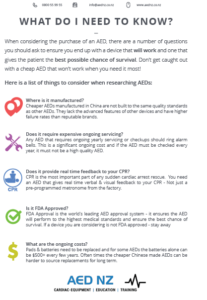The Lifesaving Investment: Understanding the Benefits of Purchasing an AED
In a world where unforeseen medical emergencies can strike at any moment, being prepared is not just prudent—it could mean the difference between life and death. Among the most critical tools for such situations is the Automated External Defibrillator (AED).
What is an AED?
An Automated External Defibrillator (AED) is a portable electronic device designed to analyze heart rhythms and deliver an electric shock to restore a normal heartbeat in cases of sudden cardiac arrest.
Benefits of Purchasing an AED:
Immediate Response: AEDs are designed for use by non-medical personnel in emergency situations. They provide clear, step-by-step instructions that guide users through the process of administering life-saving treatment, even without prior medical training.
Increased Survival Rates: Studies have shown that the prompt use of an AED significantly increases the chances of survival for SCA victims. For every minute that passes without defibrillation, the survival rate decreases by approximately 10%.
User-Friendly Design: AEDs are designed to be intuitive and user-friendly, with audible and visual prompts that guide users through the rescue process. Many models feature simple button interfaces and automated functions that minimize the risk of error during use.
Portability and Accessibility: AEDs are compact and lightweight, making them easy to transport and deploy in various settings, including schools, workplaces, sports facilities, and public spaces. Their widespread availability ensures that help is never far away in the event of a cardiac emergency.
Cost-Effective: While the initial investment in an AED may seem significant, the potential cost of not having one readily available can far outweigh the expense. AEDs are a one-time investment with low maintenance costs, offering long-term peace of mind and protection for both individuals and organizations.
Frequently Asked Questions (FAQs):
Q: Who can use an AED?
A: AEDs are designed to be used by anyone, regardless of prior medical training. Clear instructions provided by the device guide users through the process of administering treatment.
Q: Are AEDs safe to use?
A: Yes, AEDs are equipped with safety features that assess the patient’s heart rhythm and deliver a shock only if necessary. Automated prompts ensure that users can administer treatment effectively and safely.
Q: Do AEDs require regular maintenance?
A: Yes, AEDs typically require periodic maintenance checks to ensure that they are functioning properly. This may include regular inspections, battery checks, and electrode pad replacements as needed.
Q: Can AEDs be used on children?
A: Yes, many AED models are equipped with pediatric electrode pads or settings specifically designed for use on children. However, it’s essential to follow the device’s instructions carefully and seek appropriate training if using an AED on a child.
Conclusion:
Investing in an AED is not just a wise decision—it’s a potentially life-saving one. By providing immediate access to essential medical treatment, AEDs empower individuals and organizations to respond effectively to cardiac emergencies and improve survival rates. With their user-friendly design, portability, and proven efficacy, AEDs are a valuable addition to any public space or workplace, offering peace of mind and protection for everyone. Don’t wait until it’s too late—take the first step towards safety and security by purchasing an AED today.




